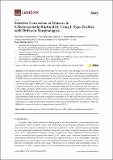Por favor, use este identificador para citar o enlazar a este item:
http://hdl.handle.net/10261/208056COMPARTIR / EXPORTAR:
 SHARE
BASE SHARE
BASE
|
|
| Visualizar otros formatos: MARC | Dublin Core | RDF | ORE | MODS | METS | DIDL | DATACITE | |

| Título: | Selective Conversion of Glucose to 5-Hydroxymethylfurfural by Using L-Type Zeolites with Different Morphologies |
Autor: | Ginés-Molina, María José; Hidayahni Ahmad, Nur; Mérida-Morales, Sandra; García-Sancho, Cristina; Mintova, Svetlana; Eng-Poh, Ng; Maireles-Torres, Pedro | Palabras clave: | Biomass Glucose 5-hydroxymethylfurfural LTL-zeolites Heterogeneous catalysis |
Fecha de publicación: | 16-dic-2019 | Editor: | Molecular Diversity Preservation International | Citación: | Catalysts | Resumen: | [EN] In the present work, the morphology of L-type zeolite (LTL topology) has been modified in order to evaluate the influence of several protonated-form LTL-zeolites with different morphologies on their stability and catalytic performance in the conversion of glucose into 5-hydroxymethylfurfural (5-HMF). Physico-chemical characterization of the LTL-based catalysts has revealed that the three types of morphologies (needle, short rod and cylinder) are active, providing complete glucose conversion and high 5-HMF yield values. The addition of CaCl2 had a positive influence on the catalytic performance. It was found that morphology influences the textural and acid properties of LTL-zeolites, and hence their catalytic performance. The best catalytic results have been obtained with the NEEDLE-LTL, showing nanoparticles with a length of 4.46 μm and a width of 0.63 μm, which attains a 5-HMF yield of 63%, at 175 °C after 90 min of reaction, and a glucose conversion of 88%. The reusability study has revealed a progressive decrease in 5-HMF yield after each catalytic cycle. Different regeneration methods have been essayed without recovering the initial catalytic activity. The presence of organic molecules in micropores has been demonstrated by TG analysis, which are difficult to remove even after a regeneration process at 550 °C. | Versión del editor: | https://doi.org/10.3390/catal9121073 | URI: | http://hdl.handle.net/10261/208056 | ISSN: | 2073-4344 | E-ISSN: | 2073-4344 |
| Aparece en las colecciones: | (ICP) Artículos |
Ficheros en este ítem:
| Fichero | Descripción | Tamaño | Formato | |
|---|---|---|---|---|
| Gines_Selective_catalysts-09-01073-v2.pdf | Artículo principal versión publicada | 3,75 MB | Adobe PDF |  Visualizar/Abrir |
CORE Recommender
Page view(s)
114
checked on 14-abr-2024
Download(s)
174
checked on 14-abr-2024
Google ScholarTM
Check
Este item está licenciado bajo una Licencia Creative Commons

